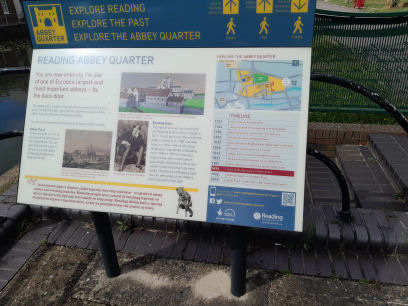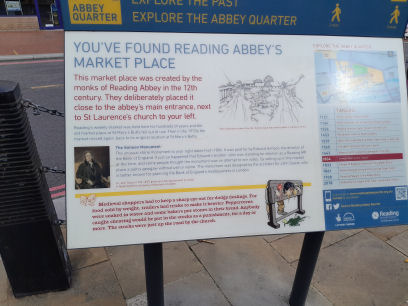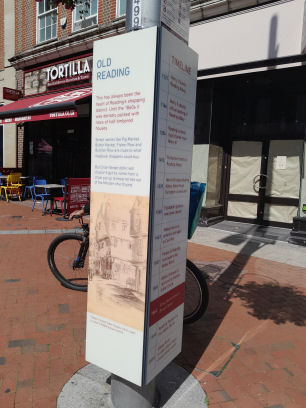

Reading AbbeyClick on a photo for a large version. |
Reading Abbey was built by Henry I, who was buried here. It was an important abbey. The abbey was mostly destroyed in 1538 during Henry VIII's Dissolution of the Monasteries. The ruins are mostly the flint core of the original walls. Flint is the only local building stones, although the walls must have been faced with good quality stone from elsewhere. This stone was removed and widely used in buildings elsewhere in Reading.
The Abbey lies between Forbury Gardens and Reading Gaol. You can enter it from the Oscar Wilde memorial path, north of the River Kennet, but there is also an entrace from Forbury Gardens.
This is listed II*, and the listing says: "Mid C19 archway incorporating numerous fragments from the C12 Abbey."
The gate leads to an artwork called the Interpretation of Ruins. See Art.
There seems to be a fence stopping you going any further. To actually get into the ruins, you need to walk to the south of the site (near the River Kennet). Remember that you can click on a photo for a larger version, so you can read the information boards, for example!
Other information boards about the Abbey and Reading, elsewhere in Reading:




There are various plaques inside the ruins commemorating the song "Sumer in icumen in" (written in the abbey), the burial of Henry I, the first Abbot of Reading, and the last Abbot of Reading.
The original abbey took considerably more area than the current ruins. Here is a map of the original area, overlaid on some modern roads and the railway.

Some of the Abbey buildings survive, apart from the ruins (above). This is the Abbey gate (marked Inner Gate, in the map). It's easy to find, as it's next to Forbury Gardens, and visible from there (see second photo).
From Visit Reading website: The Grade I listed Gateway overlooking the Forbury Gardens is a substantial part of what remains of Reading Abbey. This Gateway divided the public area of the Abbey grounds (what is now Forbury Gardens) and the private area where the rest of the ruins are. The Abbey Gateway was once part of the Reading Ladies Boarding School. This was famously attended by Jane Austen and her sister Cassandra. In 1861 the Gateway collapsed in a storm, shortly after funds had been raised for vital conservation. Instead the Gate had to be substantially rebuilt. This work was completed by Sir George Gilbert Scott, a Victorian architect known for his Gothic Revival work. He also designed Reading Gaol.
The inside of this building is not usually open to the public.
The Abbey hospitium is the other side of Forbury Gardens to the ruins. This was originally the dormitory for pilgrims of Reading Abbey. The hospitium was founded in 1189, and at its maximum comprised a range of buildings that could accommodate 400 people. The main building has survived, and is grade II listed. Much of the remainder of the original hospitium was located where Reading Town Hall now stands. It is listed grade II, and the listing says "The Hospice on site of St John's Hospice and Grammar School was built in 1486 and may incorporate some of the earlier building (founded 1196)". The building has had various uses since.
The easiest view is from the churchyard of St Lawrence (next to the town hall and Reading Museum).
You can see the other side from a private car park off Valpy Street.
There is a mysterious culvert, or small stream, which winds its way through Reading, called Holy Brook. Sometimes it disappears under housing. Sometimes it can be seen under a bridge (by the Oracle, for example). Sometimes there is a path along it.
It was used by the Abbey for a water mill. One archway remains. This is not that easy to find. There is a footpath off Abbey Street (which is off Kings Road, north of River Kennet). The grade II listing says "Late C12, early C13. Three arches... Now isolated in a development site." which about sums it up!
This is Holy Brook, by the Oracle.
© Jo Edkins 2024